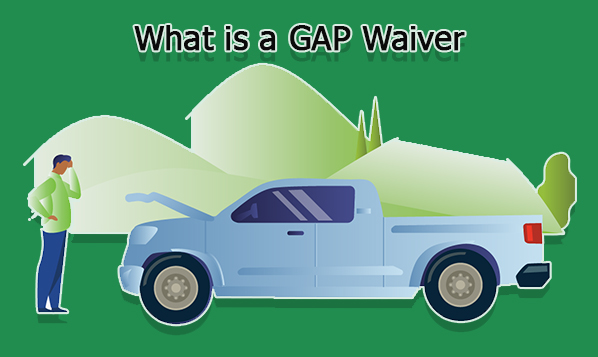It’s unpleasant enough to lose your brand-new vehicle to robbery or an accident, but having to pay more than your insurance would cover for a car you can’t drive makes things more awful. You need to take each precaution to cover against costly, unanticipated costs when obtaining or leasing a car. You may feel secure knowing that, if your car is misplaced or damaged, your debt will be completely or mostly secured if you get a GAP waiver.

The Guaranteed Asset Protection (GAP) waiver covers borrowers whose car is announced a total loss due to unanticipated circumstances. This coverage usually known as a debt cancellation agreement can remove the borrower’s responsibility to cover all or part of the difference between the loan balance and the car’s actual cash value. This article will explain how the GAP waiver works and other details relating to it.
How Does GAP Waiver Work
Your insurance company will cover the actual cash value (ACV) of your vehicle, not the $22,000 you still owe on the loan, if you purchase a car for $25,000. This implies that you are responsible for the $4,000 that is still owed on your account, and maybe extra sums for interest and other costs.
After the insurance company pays the $18,000 ACV, numerous lenders need a $4000+ payment in full. Moreover, the financial coverage against this gap is offered by a GAP waiver, which enables you to pay off your credit rapidly and conveniently so you may get a new vehicle and continue driving.
What Does GAP Cover
Your GAP waiver coverage will cover the difference between the actual cash worth of your car and its outstanding amount. Regardless of how or why it is pronounced destroyed or stolen. Certain GAP exclusions, up to an indicated sum in your contract, may cover your insurance deductible.
Also, the coverage is not insignificant. It is possible to obtain GAP coverage for both new and utilized vehicles. However, a GAP waiver does not cover all costs and circumstances, such as:
- Loan sums surpassing a certain rate of your vehicle’s loan-to-value proportion (LTV), such as $50,000, can be endorsed with up to 150% LTV.
- Refundable supplements to your lease or loan contract, such as a vehicle service contract (VSC).
- Interest on your credit collected after the date of your vehicle’s loss.
- Past-due or delinquent loan payments.
- After the loan’s initiation date, late fines and extra costs are levied.
- Automobiles bought at private auction.
What Does GAP Not Cover
Although details vary depending on the specific item and provider, GAP exclusions are frequently not offered for:
- 84-month credit conditions
- Loans that exceed a fixed limit (as mentioned in the contract)
- Commercial automobiles or those with modified or salvaged titles
Furthermore, GAP waiver coverage is accessible for the duration of your first loan. For occurrence, if you purchase a GAP waiver when refinancing your auto loan to a 36-month term, it will be effective for those 36 months.
Also, your GAP waiver will not compensate for the cost of the missed payment or any interest that amassed during that time if you take advantage of a skip-a-payment promotion or miss a payment.
When a GAP Waiver Is Helpful
Seven circumstances make it beneficial to get an optional GAP waiver, even though GAP waivers are not fundamental when financing the buying of a car (rent firms may request them):
Upside-down car loans
A GAP waiver can be useful for an upside-down car loan where the credit sum surpasses the car’s cash value. If you incidentally wreck or take an upside-down car, you would owe the bank more than the insurance would cover. The coverage would cover the highest sum of the car’s current worth.
Small down payment
When financing the buy of a new or utilized car, the amount of your down payment is critical. The LTV ratio, or the probability of owing more than the vehicle’s value, reduces with the sum of cash contributed to it. However, if your down installment for a modern car is less than 20%, getting a GAP waiver may be useful. If your car is stolen or destroyed, you’ll be responsible for out-of-pocket costs, with depreciation beginning from the minute you drive it off the lot.
High-mileage automobile
Your vehicle will lose its value more rapidly if you drive it apart. This suggests that the worth of your car may be less than the loan balance if it ever gets to be useless. If it is stolen or totaled, this might uncover your expenses.
Luxury vehicles
Compared to non-luxury automobiles, luxurious cars lose worth more rapidly. Before financing a car, consider its model, make, and depreciation rate, and consider whether to get a GAP waiver. A GAP agreement seems valuable to have in your back taken if the worth drops rapidly.
High interest rate
You pay additional interest on your loan amortization plan when you take out a car credit. The interest rate on your auto loan may influence your capacity to gather value over time. You would likely owe more on the credit than the car’s worth if the vehicle was stolen or totaled sometime recently and you had a chance to gather much equity.
Extended-duration auto loans
Long-term auto loans cause issues that are comparable to those caused by high-interest loans. It may take you longer to amass value if the advance term is longer. This uncovered you to a time outline in which the sum owed on your credit may surpass the car’s worth.
Cars for Lease
If you intend to rent a car, a few lenders require you to have GAP coverage. Moreover, the contract may include a GAP waiver or something comparable known as loan/lease coverage. The policy covers the gap between early-end recompense and the car’s value during damage or theft, requiring early rent end.

